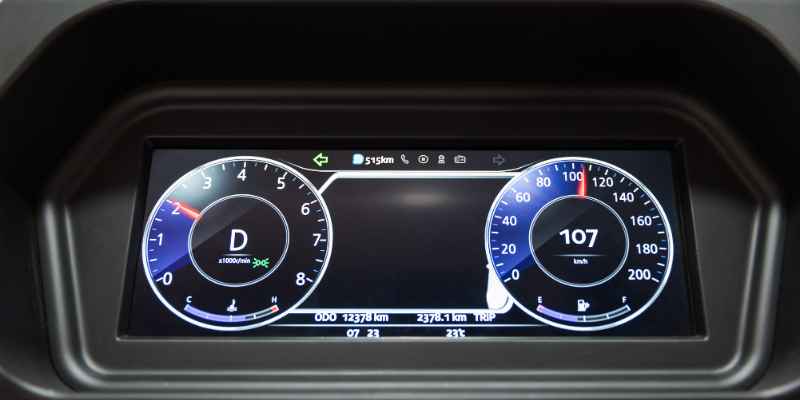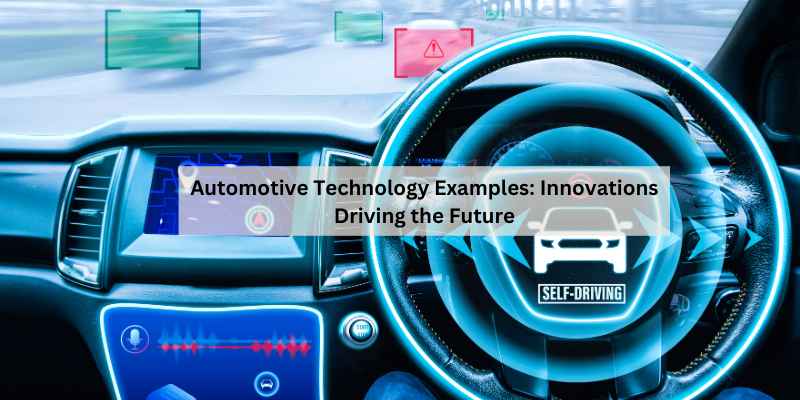Automotive Technology Examples: Innovations Driving the Future
Automotive technology examples include automotive electronics, emerging technologies, connected cars, and automotive systems technology. These examples encompass a wide range of advancements in the automotive industry, from vehicle connectivity to cyber security measures.
Understanding these technologies is essential for automotive technicians and professionals to stay current in the rapidly evolving automotive landscape. As vehicles become more complex and technologically advanced, professionals in the automotive industry must adapt to these changes. From diagnosing and servicing major automotive systems to preventing cyber-attacks, staying abreast of automotive technology examples is crucial for success in this field.
Let’s delve deeper into some key examples of automotive technology and their impact on the industry.
Electrification And Hybrid Technologies
Electrification and hybrid technologies have revolutionized automotive technology, with examples including electric vehicles, plug-in hybrids, and regenerative braking systems. These advancements aim to reduce emissions and improve fuel efficiency, shaping the future of sustainable transportation.
Electrification and Hybrid Technologies have revolutionized the automotive industry by addressing the issue of carbon emissions and fuel efficiency. Battery advancements, hybrid system innovations, and other emerging technologies have paved the way for a sustainable and eco-friendly future.
Battery Advancements
Battery technology has come a long way since the first lead-acid battery was invented. With the advent of lithium-ion batteries, electric vehicles can now travel longer distances and charge faster. Solid-state batteries are the next big thing in battery technology, with the potential to offer even greater energy density and safety.
Hybrid System Innovations
Hybrid vehicles combine the power of an electric motor with a gasoline engine to provide better fuel efficiency and reduced emissions. The latest hybrid systems can automatically switch between electric and gasoline power based on driving conditions, offering a seamless driving experience. Some hybrids even have the ability to recharge their batteries through regenerative braking, further improving their efficiency.
In conclusion, electrification and hybrid technologies have brought about significant advancements in the automotive industry. Battery advancements and hybrid system innovations are just a few examples of how technology is driving the industry towards a more sustainable future.
Autonomous Driving Systems
Explore cutting-edge Automotive Technology Examples like Autonomous Driving Systems, revolutionizing the driving experience with advanced sensors and AI algorithms for enhanced safety and convenience on the roads. Join the future of mobility with self-driving vehicles leading the way in automotive innovation.
Autonomous Driving Systems represent a groundbreaking advancement in automotive technology, aiming to revolutionize transportation by enabling vehicles to operate without human intervention. These systems utilize a combination of sensor technologies and artificial intelligence to perceive and interpret the surrounding environment, make decisions, and navigate the vehicle safely to its destination.
Levels Of Autonomy
The Society of Automotive Engineers (SAE) categorizes autonomous driving into six levels, ranging from Level 0 with no automation to Level 5 with full automation. Each level signifies the extent of driver assistance and vehicle control, with Level 5 being the ultimate goal of achieving fully autonomous vehicles capable of operating without any human intervention.
Sensor And Ai Developments
Advancements in sensor technologies, such as LiDAR, radar, and cameras, play a crucial role in enabling autonomous driving systems to perceive and interpret their surroundings accurately. These sensors collect real-time data, which is processed by sophisticated artificial intelligence algorithms to make decisions regarding vehicle control, navigation, and response to dynamic driving conditions.
In conclusion, Autonomous Driving Systems represent a significant technological leap in the automotive industry, with ongoing developments in sensor technologies and artificial intelligence paving the way for safer, more efficient, and ultimately autonomous vehicles.
Connectivity And Infotainment
When it comes to automotive technology, connectivity and infotainment have revolutionized the driving experience, offering an array of in-car features and entertainment systems that have evolved over time.
In-car Connectivity Features
Modern vehicles are equipped with advanced in-car connectivity features that enable seamless integration with smartphones and other devices. These features include:
- Bluetooth connectivity for hands-free calling and audio streaming
- Wireless charging pads for smartphones
- Integration with voice assistants such as Apple CarPlay and Android Auto
- Wi-Fi hotspots for on-the-go connectivity
Evolution Of Infotainment Systems
Infotainment systems have undergone a remarkable evolution, transforming from simple radio units to sophisticated multimedia hubs. The evolution can be seen in the following key developments:
- Integration of touchscreen displays for intuitive user interaction
- Enhanced navigation systems with real-time traffic updates
- Integration of Apple CarPlay and Android Auto for seamless smartphone connectivity
- Voice recognition technology for hands-free control
- Integration of entertainment options such as streaming services and digital radio
Advanced Driver Assistance Systems (adas)

Advanced Driver Assistance Systems (ADAS) refer to the advanced technologies designed to assist drivers in the driving process. These systems aim to enhance vehicle safety and improve the overall driving experience. From safety features to integration with autonomous technology, ADAS is revolutionizing the automotive industry.
Safety Features
ADAS encompasses a wide array of safety features that are designed to mitigate the risk of accidents and enhance overall road safety. These features include adaptive cruise control, lane departure warning systems, automatic emergency braking, blind-spot detection, and forward collision warning, among others. These technologies work together to provide drivers with real-time assistance, helping them to avoid potential hazards and minimize the likelihood of collisions.
Integration With Autonomous Tech
ADAS plays a crucial role in the integration with autonomous technology. By leveraging sensors, cameras, and sophisticated algorithms, ADAS enables vehicles to perceive their surroundings, make informed decisions, and even take autonomous actions when necessary. This integration paves the way for the development of self-driving cars, where ADAS serves as the foundation for the autonomous driving capabilities of vehicles.
Lightweight Materials And Design
When it comes to automotive technology, the use of lightweight materials and innovative design has revolutionized the industry. From enhancing fuel efficiency to improving performance, manufacturers have been integrating advanced materials and aerodynamic features to create cutting-edge vehicles.
Use Of Carbon Fiber
Carbon fiber has become a game-changer in the automotive industry due to its exceptional strength and lightweight properties. This material is extensively used in the construction of vehicle components such as body panels, chassis, and interior elements. The use of carbon fiber not only reduces the overall weight of the vehicle but also enhances its structural integrity, contributing to improved performance and fuel efficiency.
Aerodynamic Enhancements
Aerodynamic enhancements play a crucial role in reducing drag and optimizing airflow around the vehicle. Manufacturers have been incorporating advanced design elements such as streamlined body shapes, active grille shutters, and underbody panels to minimize air resistance. By improving aerodynamics, vehicles can achieve better fuel economy and higher top speeds, ultimately enhancing the overall driving experience.
Alternative Fuel Technologies
When it comes to the advancement of automotive technology, alternative fuel technologies have emerged as a sustainable and eco-friendly solution. From hydrogen fuel cells to biofuels and synthetic fuels, these innovations are shaping the future of the automotive industry.
Hydrogen Fuel Cells
Hydrogen fuel cells are gaining traction as a promising alternative to traditional gasoline-powered vehicles. These cells generate electricity by combining hydrogen with oxygen, producing water and heat as byproducts. This sustainable energy source has the potential to revolutionize the automotive sector with zero-emission vehicles.
Biofuels And Synthetic Fuels
Biofuels, derived from organic materials such as plants and algae, offer a renewable alternative to fossil fuels. They can be blended with traditional gasoline or diesel, reducing greenhouse gas emissions. On the other hand, synthetic fuels, produced from carbon dioxide and renewable energy sources, present a viable option for sustainable mobility, contributing to a cleaner environment.
Telematics And Vehicle Tracking
Telematics and vehicle tracking have revolutionized the automotive industry, providing real-time data and insights for enhanced efficiency and safety.
Fleet Management
Fleet management systems utilize telematics to monitor and optimize the performance of a fleet of vehicles, improving operational effectiveness.
Insurance Telematics
Insurance telematics involves the use of tracking devices to collect data on driving behavior, enabling personalized insurance premiums based on individual risk profiles.
Cybersecurity In Modern Vehicles
Modern vehicles showcase advanced automotive technology examples, including sophisticated cybersecurity measures to protect against cyber threats. These systems ensure the safety and security of vehicles by safeguarding critical functions from potential cyber attacks.
As technology advances, so do the risks of cyber-attacks on modern vehicles. With the increasing connectivity of vehicles, hackers can potentially gain access to critical systems, such as brakes and steering. Therefore, it is important to implement strong cybersecurity measures to protect against such attacks.
Protecting Against Cyber-attacks
One way to protect against cyber-attacks is to implement secure software and hardware systems. This includes using encryption to protect data transmitted between different systems within the vehicle and ensuring that all software and hardware components are updated regularly with the latest security patches.
Secure Vehicle-to-everything Communication
Secure vehicle-to-everything (V2X) communication is crucial for ensuring the safety of modern vehicles. V2X communication allows vehicles to communicate with other vehicles, infrastructure, and even pedestrians. However, it is important that these communications are secure and protected from cyber-attacks. This can be achieved through the use of secure communication protocols and encryption.
To sum up, implementing strong cybersecurity measures is crucial for ensuring the safety of modern vehicles. Protecting against cyber-attacks and ensuring secure V2X communication are just a few examples of the measures that can be taken to achieve this. As the automotive industry continues to evolve and become more connected, it is important to stay vigilant and proactive in protecting against potential cyber threats.

Frequently Asked Questions
What Do You Mean By Automotive Technology?
Automotive technology involves studying self-propelled vehicles like cars, trucks, and marine vehicles. It includes design, engineering, mechanics, and computer technology.
What Are Examples Of Automotive?
Automotive examples include cars, trucks, sports vehicles, marine crafts, and tractor-trailers. Automotive technology covers various self-propelled machines.
What Is Automotive Systems Technology?
Automotive systems technology refers to the study of self-propelled vehicles and machines, including repair and maintenance.
What Is The Basic Of Automotive Technology?
Automotive technology is the study of self-propelled vehicles and their design, engineering, mechanics, and computer systems. This includes standard automobiles, sports cars, tractor-trailers, marine vehicles, and more. The technology involves understanding how these vehicles move and addressing engine and other system repairs.
Conclusion
Automotive technology encompasses a wide range of vehicles and systems. From standard cars to marine vehicles, the field is constantly evolving with emerging technologies. Automotive technicians play a crucial role in repairing and maintaining these vehicles, ensuring safe and efficient transportation for all.







